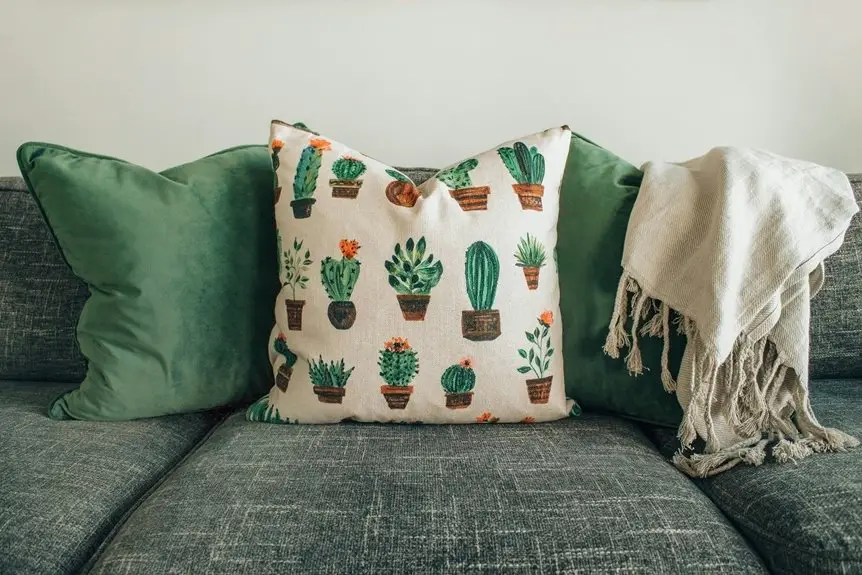To remove the formaldehyde smell from new furniture fabrics, start by airing out your furniture in a well-ventilated area. Open windows and use fans to improve airflow. Natural deodorizers like baking soda or activated charcoal can absorb odors effectively. You might also consider cleaning with vinegar and baking soda for added odor-fighting power. If the smell persists, professional treatments may provide a deeper clean. Stick around to discover more effective methods and solutions.
Table of Contents
Key Takeaways
- Air out new furniture by opening windows and doors for a few hours daily to promote fresh air circulation and reduce odors.
- Use fans to improve airflow around the furniture, enhancing the effectiveness of the airing-out process.
- Employ natural deodorizers like baking soda, activated charcoal, or essential oils to neutralize and absorb unpleasant smells.
- Consider professional treatments such as steam cleaning or eco-friendly solutions specifically designed to neutralize formaldehyde.
- Regularly check for lingering odors and continue airing out or using deodorizers as needed to maintain a fresh environment.
Understanding Formaldehyde and Its Effects
Although you may not realize it, formaldehyde is a common chemical found in many household products, including furniture fabrics. This colorless gas can off-gas from items like pressed wood, upholstery, and insulation.
When you breathe in formaldehyde, it might cause symptoms like irritation of the eyes, nose, and throat. You could also experience headaches, coughing, and even allergic reactions. Long-term exposure might lead to more serious health issues, including respiratory problems and increased cancer risk.
Recognizing these potential effects is vital for maintaining a healthy home environment. So, it’s important to be aware of the products you bring into your space and their chemical compositions.
Taking proactive steps can help minimize exposure and safeguard your well-being in your living area.
Airing Out Your Furniture
Airing out your furniture is essential for reducing that pesky formaldehyde smell.
By ensuring ideal ventilation, you can help fresh air circulate and carry away the odor.
Aim to air out your pieces for a few hours each day to see the best results.
Importance of Fresh Air
When you bring new furniture into your home, letting fresh air circulate around it’s essential for reducing any lingering formaldehyde smell.
Fresh air helps to dilute the concentration of volatile organic compounds, like formaldehyde, that can off-gas from your furniture. Opening windows and doors creates a cross breeze, allowing harmful particles to escape and encouraging cleaner air to flow in.
This simple step can greatly improve indoor air quality and make your space more comfortable. Remember to take into account the weather and outdoor air quality, as both can impact the effectiveness of airing out your furniture.
Optimal Ventilation Techniques
How can you effectively ventilate your new furniture to eliminate that persistent formaldehyde smell? Here are some ideal techniques to help air it out:
- Open Windows: Let fresh air circulate by opening windows and doors, creating a cross-breeze that helps disperse the odor.
- Use Fans: Position fans to enhance airflow around the furniture, pushing stale air out and drawing fresh air in.
- Place Outdoors: If possible, set your furniture outside in a shaded area for a few hours on a breezy day, allowing natural ventilation.
- Utilize Air Purifiers: Invest in an air purifier with a HEPA filter to reduce airborne pollutants, including formaldehyde fumes.
Duration for Airing Out
Effective ventilation techniques can considerably reduce the formaldehyde smell in your furniture, but knowing how long to air it out is equally important.
Ideally, you should let your furniture air out for at least 48 to 72 hours. However, depending on the severity of the smell, you might need to extend this period.
During this time, keep windows open and fans running to guarantee a steady flow of fresh air. Check the furniture regularly; if the smell lingers after a few days, continue airing it out.
Don’t forget to rotate or move items occasionally to expose all surfaces. By following these guidelines, you’ll create a healthier environment and enjoy your new furniture without the unpleasant odors.
Using Natural Deodorizers
Although formaldehyde can linger in furniture fabrics, using natural deodorizers offers an effective way to combat the unpleasant smell.
These natural solutions not only freshen your space but also promote a healthier environment.
Here are four deodorizers you can try:
- Baking soda: Sprinkle it on the fabric, let it sit for a few hours, then vacuum it up.
- Activated charcoal: Place bags of activated charcoal near the furniture to absorb odors.
- Essential oils: Mix a few drops with water in a spray bottle and lightly mist the fabric.
- Coffee grounds: Place bowls of coffee grounds nearby; they’ll neutralize odors naturally.
With these natural deodorizers, you’ll breathe easier and enjoy a fresher home.
Cleaning With Vinegar and Baking Soda
Natural deodorizers can work wonders, but sometimes a deeper clean is necessary to tackle the formaldehyde smell in furniture fabrics.
Vinegar and baking soda are two powerful allies in this battle. Start by mixing equal parts of water and white vinegar in a spray bottle. Lightly mist the fabric, ensuring it’s damp but not soaked. Let it sit for about 15 minutes to penetrate the fibers.
Next, sprinkle baking soda over the fabric, focusing on areas with the strongest odors. Allow it to sit for several hours or overnight, then vacuum the baking soda away.
This method not only neutralizes the smell but also helps remove dirt and allergens, leaving your furniture feeling fresher and cleaner.
Utilizing Activated Charcoal
If you’re looking for a powerful way to eliminate the formaldehyde smell from your furniture fabrics, utilizing activated charcoal is an excellent choice. This natural odor absorber works wonders in trapping harmful compounds, leaving your space fresher.
Here’s how to use it effectively:
- Purchase Activated Charcoal: Look for either bags or loose granules at your local store or online.
- Place Charcoal in Bowls: Set small bowls filled with activated charcoal around your furniture to maximize absorption.
- Leave for Several Days: Allow the charcoal to sit for at least 48 hours; the longer, the better.
- Replace Regularly: Refresh the charcoal every few weeks to maintain its effectiveness.
Using activated charcoal is a simple, eco-friendly solution to rid your home of that unpleasant smell.
Professional Treatments and Solutions
When you’re dealing with persistent formaldehyde odors in your furniture fabrics, seeking professional treatments can provide effective and lasting solutions.
Experts often utilize specialized cleaning methods designed to neutralize these harmful chemicals. One popular approach is steam cleaning, which penetrates deeply into the fabric, eliminating odors at the source.
Additionally, some professionals may apply eco-friendly treatments that bond with formaldehyde molecules, neutralizing them completely.
If you’re considering this route, research local services and read reviews to find a reputable provider.
Always inquire about the products they use, ensuring they align with your health and environmental standards.
With the right professional help, you can enjoy your new furniture without the lingering smell of formaldehyde.
Frequently Asked Questions
How Long Does the Formaldehyde Smell Typically Last?
Imagine a stubborn cloud lingering after a storm. The formaldehyde smell often lasts a few days to weeks, depending on ventilation and temperature. You can hasten its departure by airing out the space effectively.
Can Pets Be Affected by Formaldehyde in Furniture?
Yes, pets can be affected by formaldehyde exposure. They might experience respiratory issues or skin irritations. It’s important to guarantee proper ventilation and limit their time around new furniture to minimize any potential health risks.
Are There Specific Furniture Brands That Emit Less Formaldehyde?
Wondering if some furniture brands are safer? You’ll find that companies like IKEA and West Elm often prioritize low-emission materials, so you can enjoy your space without worrying about harmful chemicals lurking in your new furniture.
Is It Safe to Sleep Near New Furniture?
It’s generally safe to sleep near new furniture, but you might experience some discomfort from odors. If you’re sensitive, consider airing out the room or using air purifiers to reduce any potential effects.
What Symptoms Indicate Formaldehyde Sensitivity?
Imagine walking into a room and feeling a tightness in your chest. If you’re experiencing headaches, dizziness, or skin irritation, you might have formaldehyde sensitivity. Listen to your body; it knows when something’s off.
- Repairing an Elbow in a Corduroy Shirt: A Step-by-Step Guide - July 6, 2025
- Remove Pine Pitch From Corduroy Pants: Easy Cleaning Tips - July 6, 2025
- Upcycle With Corduroy: Creative Ideas for Fabric Lovers - July 6, 2025







